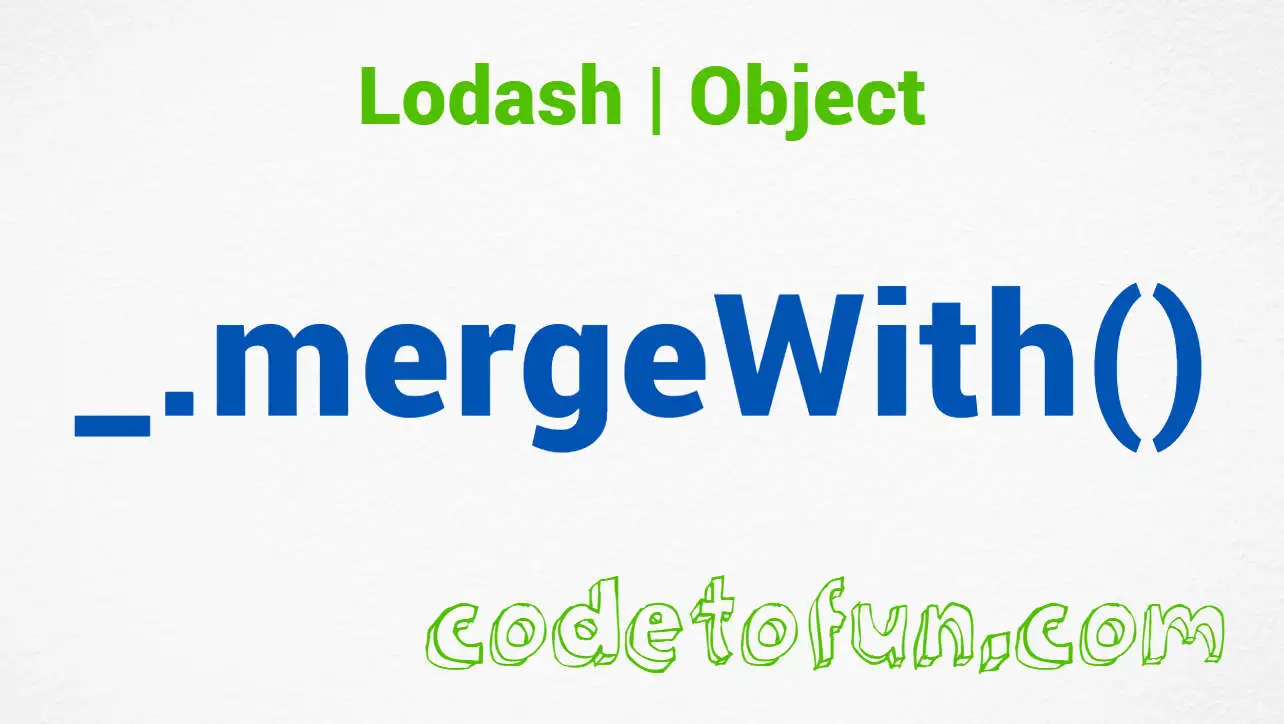
Lodash Home
- Lodash Intro
- Lodash Array
- Lodash Collection
- Lodash Date
- Lodash Function
- Lodash Lang
- Lodash Math
- Lodash Number
- Lodash Object
- _.assign
- _.assignIn
- _.assignInWith
- _.assignWith
- _.at
- _.create
- _.defaults
- _.defaultsDeep
- _.findKey
- _.findLastKey
- _.forIn
- _.forInRight
- _.forOwn
- _.forOwnRight
- _.functions
- _.functionsIn
- _.get
- _.has
- _.hasIn
- _.invert
- _.invertBy
- _.invoke
- _.keys
- _.keysIn
- _.mapKeys
- _.mapValues
- _.merge
- _.mergeWith
- _.omit
- _.omitBy
- _.pick
- _.pickBy
- _.result
- _.set
- _.setWith
- _.toPairs
- _.toPairsIn
- _.transform
- _.unset
- _.update
- _.updateWith
- _.values
- _.valuesIn
- Lodash Seq
- Lodash String
- Lodash Util
- Lodash Properties
- Lodash Methods
Lodash _.mergeWith() Object Method

Photo Credit to CodeToFun
🙋 Introduction
In the realm of JavaScript development, managing complex objects and their merging operations can be challenging. Enter Lodash, a powerful utility library that offers a plethora of functions to simplify object manipulation. Among these functions lies the _.mergeWith() method, a versatile tool for merging two or more objects while allowing customization through a provided customizer function.
This method enhances code flexibility and maintainability, making it indispensable for developers dealing with nested or conflicting data structures.
🧠 Understanding _.mergeWith() Method
The _.mergeWith() method in Lodash is designed to merge two or more objects into a single object while allowing developers to define custom merging behavior. This customizability is achieved through a provided customizer function, which enables precise control over how conflicting properties are resolved during the merge operation.
💡 Syntax
The syntax for the _.mergeWith() method is straightforward:
_.mergeWith(object, sources, customizer)- object: The destination object to merge into.
- sources: The source objects to merge from.
- customizer: The function invoked to customize merging behavior.
📝 Example
Let's dive into a simple example to illustrate the usage of the _.mergeWith() method:
const _ = require('lodash');
const targetObject = {
a: {
value: 1,
details: {
type: 'number'
}
},
b: {
value: 2,
details: {
type: 'number'
}
}
};
const sourceObject = {
a: {
value: 3
},
b: {
details: {
description: 'This is object b'
}
},
c: {
value: 4
}
};
function customizer(objValue, srcValue, key, object, source) {
if(_.isObject(objValue)) {
return _.mergeWith(objValue, srcValue, customizer);
}
return srcValue;
}
const mergedObject = _.mergeWith(targetObject, sourceObject, customizer);
console.log(mergedObject);In this example, the targetObject and sourceObject are merged using _.mergeWith(), with a customizer function customizer() provided to customize the merge behavior. The result is stored in mergedObject, where conflicting properties are resolved according to the logic defined in the customizer function.
🏆 Best Practices
When working with the _.mergeWith() method, consider the following best practices:
Understand Customizer Function:
Familiarize yourself with the customizer function provided to
_.mergeWith(). This function allows you to define how conflicting properties should be merged, providing granular control over the merge operation.example.jsCopiedfunction customizer(objValue, srcValue, key, object, source) { if(_.isObject(objValue)) { return _.mergeWith(objValue, srcValue, customizer); } return srcValue; }Handle Nested Objects:
Ensure that your customizer function can handle nested objects appropriately. This is crucial for scenarios involving deeply nested data structures where conflicts may occur at multiple levels.
example.jsCopiedfunction customizer(objValue, srcValue, key, object, source) { if(_.isObject(objValue)) { return _.mergeWith(objValue, srcValue, customizer); } return srcValue; }Test with Various Scenarios:
Thoroughly test your merge operations with a variety of scenarios, including different object structures and customizer functions. This ensures that your merging logic behaves as expected across different use cases.
example.jsCopiedconst object1 = { a: { b: 1 } }; const object2 = { a: { c: 2 } }; const mergedObject = _.mergeWith(object1, object2, (objValue, srcValue) => objValue + srcValue); console.log(mergedObject); // Output: { a: { b: 1, c: 2 } }
📚 Use Cases
Resolving Conflicts in Object Merging:
_.mergeWith()is particularly useful when merging objects with conflicting properties, allowing developers to define custom resolution strategies for handling these conflicts.example.jsCopiedconst targetObject = { a: { value: 1 } }; const sourceObject = { a: { value: 2 } }; const mergedObject = _.mergeWith(targetObject, sourceObject, (objValue, srcValue) => objValue + srcValue); console.log(mergedObject); // Output: { a: { value: 3 } }Customized Merging Logic:
In scenarios where standard merging behavior is insufficient,
_.mergeWith()empowers developers to implement custom merging logic tailored to their specific requirements.example.jsCopiedconst targetObject = { a: { value: 1 } }; const sourceObject = { a: { value: 2 } }; function customizer(objValue, srcValue) { return objValue * srcValue; } const mergedObject = _.mergeWith(targetObject, sourceObject, customizer); console.log(mergedObject); // Output: { a: { value: 2 } }Deeply Nested Object Merging:
For scenarios involving deeply nested objects,
_.mergeWith()provides a convenient solution for merging complex data structures while preserving the integrity of nested properties.example.jsCopiedconst targetObject = { a: { b: { c: 1 } } }; const sourceObject = { a: { b: { d: 2 } } }; const mergedObject = _.mergeWith(targetObject, sourceObject, (objValue, srcValue) => objValue + srcValue); console.log(mergedObject); // Output: { a: { b: { c: 1, d: 2 } } }
🎉 Conclusion
The _.mergeWith() method in Lodash offers a powerful solution for merging objects with customizable merging behavior. Whether you need to resolve conflicts, implement custom merging logic, or handle deeply nested data structures, _.mergeWith() provides the flexibility and control required for efficient object manipulation in JavaScript.
By adhering to best practices and exploring diverse use cases, you can harness the full potential of the _.mergeWith() method in your Lodash projects.
👨💻 Join our Community:
Author

For over eight years, I worked as a full-stack web developer. Now, I have chosen my profession as a full-time blogger at codetofun.com.
Buy me a coffee to make codetofun.com free for everyone.
Buy me a CoffeeShare Your Findings to All
Recent Post in lodash


Lodash _.templateSettings.imports Property

Lodash _.templateSettings.evaluate Property

Lodash _.templateSettings Property

Lodash _.templateSettings.escape Property

Lodash _.templateSettings.interpolate Property








If you have any doubts regarding this article (Lodash _.mergeWith() Object Method), please comment here. I will help you immediately.